
Описание
Страна: Франция
Год: 1911
Варианты
- REP - REP Type D / N - 1911 - Франция
- REP - hydro-monoplane - 1912 - Франция
- J.Davilla, A.Soltan French Aircraft of the First World War (Flying Machines)
- L.Opdyke French Aeroplanes Before the Great War (Schiffer)
- Jane's All The World Aircraft 1913
- Журнал Flight
-
Журнал - Flight за 1911 г.
The R.E.P. stand at the Paris Aero Show, and the new 90-b.p. 7-cyl. R.E.P. motor.
-
Журнал - Flight за 1911 г.
Detail view, showing the front section of the beautifully constructed R.E.P. monoplane.
-
Журнал - Flight за 1912 г.
Mr. Gordon Bell standing in front of one of the R.E.P. monoplanes on which he has been making such splendid flights during the past few weeks over Buc and the surrounding country.
-
Журнал - Flight за 1912 г.
THE FIRST MONOPLANES FOR THE TURKISH ARMY. - Standing in the pilot's seat of the R.E.P. (left-hand machine) is Commander Fessa Bey, the first Turkish military pilot. In front the Turkish Military Commission is seen, the fifth from the left being Gen. Mabmud Schefket Pasha, the Turkish War Minister. On the right is a British pilot, who has been engaged, with his R.E.P. monoplane, by the Turkish Army as instructor.
Другие самолёты на фотографии: Deperdussin D/TT - Франция - 1912
-
Журнал - Flight за 1912 г.
Representative stand at the Salon - the Breguet-R.E.P.
Другие самолёты на фотографии: Breguet 3 - Франция - 1910
-
Журнал - Flight за 1913 г.
The R.E.P. at the Paris Salon.
-
Журнал - Flight за 1914 г.
The R.E.P. monoplane.
-
A.Durkota, T.Darcey, V.Kulikov - The Imperial Russian Air Service /Flying Machines/
Lachmann in the cockpit of a R.E.P. N at the R.E.P. School in Buc. The date on the photo is July 20,1914, most likely after a solo flight examination to complete the course of instruction. He was awarded his Brevet no.1721 the following day. It was possible he preferred to be known as Marcel since the photo is signed in that manner.
-
J.Davilla, A.Soltan - French Aircraft of the First World War /Flying Machines/
R.E.P. Type N at Avord. Lateral control was by wing warping, the wires for which were supported by two large pylons located in front of the cockpit.
-
P.Jarrett - Pioneer Aircraft: Early Aviation Before 1914 /Putnam/
A French military aviator prepares to depart on a reconnaissance flight in an REP monoplane in 1914. The breed died out during the First World War.
-
J.Davilla, A.Soltan - French Aircraft of the First World War /Flying Machines/
The R.E.P. Type N in service with the Aviation Militaire.
-
Журнал - Flight за 1911 г.
TUBULAR STEEL WORK IN AEROPLANE CONSTRUCTION. - The above photograph is an excellent example of a tubular steel frame for a monoplane body, the machine illustrated being the latest R.E.P. Forming a background to the body are the wings.
-
Журнал - Flight за 1911 г.
THE LATEST R.E.P. MONOPLANE. - The fuselage before the mounting of its planes, &c# showing the method of construction adopted for the framework, landing chassis, fixing of the engine, &c.
-
L.Opdyke - French Aeroplanes Before the Great War /Schiffer/
The uncovered REP Type D at the Musee de l'Air et de I'Espace.
-
Журнал - Flight за 1914 г.
The skeleton of the all-steel R.E.P. fuselage.
-
Журнал - Flight за 1911 г.
The R.E.P. monoplane.
J.Davilla, A.Soltan French Aircraft of the First World War (Flying Machines)
R.E.P. N
Only one aircraft designed and produced by the R.E.P. firm saw action with the Aviation Militaire during the war. This was the R.E.P. N, a two-seat reconnaissance aircraft with a shoulder-mounted wing and powered by a 80-hp Gnome or Le Rhone engine in a semi-enclosed cowling. The fuselage had a triangular cross section with a "keel" along its base. The plane was constructed of fabric-covered steel tubing. There was a very small rudder and a large tailplane/elevator assembly. Lateral control was by wing warping, the wires for which were supported by two large pylons in front of the observer's and pilot's cockpits.
Two units used the R.E.P. N operationally. The first was REP 15, formed in 1912 at Reims. Initially the escadrille was based at Mailly in 1913. At the outbreak of war it was assigned to the General Aviation Reserve at Saint-Cyr in the 5th Armee sector. The R.E.P. Ns flew reconnaissance missions during the Battles of Charleroi and the Marne. In October 1914 the unit was assigned to the 10th Armee sector near Artois where it remained until April 1915. On that date MS 15 was formed with Morane-Saulnier Type Ls.
The other unit was REP 27, assigned to the 10th Armee at the outbreak of the War. It, too, participated in the Battle of the Marne. According to an SHAA document, the personnel of REP 15 and REP 27 were joined into a single escadrille to form C 27 with Caudron G.3s on 8 January 1915. However, apparently a few R.E.P. Ns were retained on strength, as one belonging to escadrille 1 5 is recorded as destroying an Aviatik near Lanevin on 2 March 1915 with a carbine.
No other escadrilles were formed on the R.E.P. Ns and further development was abandoned, probably because the shoulder-mounted wing obstructed the crew's visibility - a fatal flaw in an aircraft intended for reconnaissance duty.
After the failure of the R.E.P. N, the firm undertook the license production of Voisin aircraft, then Caproni bombers.
Foreign Service
Serbia
Two R.E.P. Ns destined for Turkey were seized in transit by the Serbian authorities at the outbreak of the First Balkan War. An third R.E.P. N was later obtained when a Turkish example was captured. The Serbians appear to have made only limited use of these planes; most combat missions were flown by Bleriot 11s purchased from France.
Turkey
By 1912 the Ottoman air service had 17 aircraft on strength, most of them R.E.P. Ns, which were considered by the Turks to be a sturdy monoplane. Records indicate there were several 60-hp monoplanes, various two-seat trainers with 80-hp engines, and a two-seat reconnaissance machine with a 70-hp engine. Before the First Balkan War an R.E.P. N was sent to Thessalonica, where it was later captured by the Serbians, as was a second sent there at the outbreak of the war. Numerous sorties were flown by the two remaining R.E.P.s over Thessalonica, Fesa, Nuri, Salim, Fazil, Midhat, Refik, and Fevzi during both Balkan Wars. A U. S. War Department report of October 29 1914 listed four R.E.P. Ns at the Yesilkoy flight school. By the time the First World War began the surviving R.E.P. Ns had been relegated to training.
R.E.P. Two-Seat Reconnaissance Plane with a 80-hp Gnome or Le Rhone
Span 9.2 m, length 6.6 m
Empty weight 270 kg
Maximum speed: 116 km/h
Armament: limited to hand-held weapons improvised by the crew
Описание:


















